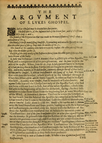St. Luke’s Gospel may be divided into five parts.
The first part is, of the Infancy both of the Precursor, and of Christ himself: chap. 1 and 2.
The second, of the Preparation that was made to the manifestation of Christ: chap. 3 and a piece of the 4.
The third, of Christ’s manifesting himself, by preaching and miracles specially in Galilee: the other piece of the 4 chap. unto the midst of the 17.
The fourth of his coming into Jewry towards his Passion: the other piece of the 17 chap. unto the midst of the 19.
The fifth, of the Holy week of his Passion in Jerusalem: the other part of the 19 chap. unto the end of the book.
St. Luke was Sectatour (saith S. Jerome) that is, a Disciple of the Apostle Paul, and a companion of all his peregrination. And the same we see in the Acts of the Apostles: Where, from the 16 chap. St. Luke putteth himself in the train of St. Paul, writing thus in the story: Forthwith we sought to go into Macedonia. And in like manner, in the first person, commonly through the rest of that book. Of him and his Ghospel, St. Jerom understandeth this saying of S. Paul: We have sent with him the brother, whose praise is in the Ghospel through all Churches. Where also he addeth: Some suppose, so often as Paul in his Epistles saith, According to my Ghospel, that he meaneth of Luke’s book. And again: Luke learned the Ghospel not only of the Apostle Paul, who had not been with our Lord in flesh, but of the other Apostles; which himself also in the beginning of his book declareth, saying: As they delivered to us who themselves from the beginning saw, and were Ministers of the Word. It followeth in St. Jerome: Therefore he wrote the Ghospel, as he had heard; but the Acts of the Apostles he compiled as he had seen. St. Paul writeth of him by name to the Colossians: Luke the Physician saluteth you. And to Timothie: Luke alone is with me. Finally of his end thus doth St. Jerom write: He lived fourscore and four years, having no wife. He is buried at Constantinople; to which city his bones with the Relics of Andrew the Apostle were translated out of Achaia the twentieth year of `Constantinus: And of the same Translation also in another place against Vigilantius the Heretic: It grieveth him that the Relics of the Martyrs are covered with precious coverings, and that they are not either tied in cleats or thrown to the dunghill. Why, are we then [a] sacrilegious, when we enter the Churches of the Apostles? Was `Constantinus the Emperor sacrilegious, who translated to Constantinople the holy Relics of Andrew, Luke, and Timothy, at which the Devils roar, and the inhabiters of Vigilantius confess that they feel their presence?
His sacred body is now at Padua in Italy; Wither it was again translated from Constantinople.
Footnotes
- ↑ The Heretic so counted the Catholics for their honouring of Saints and Relics.
Margin Notes
- Jer. in Catalago.
- 2. Cor. 8, 8.
- Luc. 1, 2.
- Col. 4, 14.
- 2. Tim. 4, 11.
- Jero. in Catalogo.
- Jer. con. Vigil. c. 2.
Margin References
- `Constantius
- `Constantius

